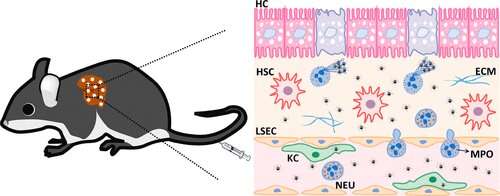This article has been reviewed according to Science X's editorial process and policies. Editors have highlighted the following attributes while ensuring the content's credibility:
fact-checked
peer-reviewed publication
trusted source
proofread
Researchers develop new imaging approach to diagnose advanced form of non-alcoholic fatty liver disease

Non-alcoholic fatty liver disease is the most common chronic liver disease in the world. In its advanced form, non-alcoholic steatohepatitis (NASH), is curable when diagnosed and treated in its early stages. However, when left untreated, it could progress to the irreversible stage of liver cirrhosis and cancer, making early diagnosis imperative.
However, to date, the only approach to definitively diagnose NASH is through a liver biopsy, which is often painful and invasive to patients. This renders an urgent need to develop better diagnostic approaches for NASH.
To tackle this issue, Assistant Professor Wang Jiong-Wei from the Department of Surgery and Nanomedicine Translational Research Program at the Yong Loo Lin School of Medicine, National University of Singapore (NUS Medicine), in collaboration with Professor Liu Bin from Chemical and Biomolecular Engineering at the College of Design and Engineering, National University of Singapore, led a team to develop an enzyme-sensitive nanoprobe to improve the accuracy and sensitivity of diagnosing NASH using an MRI technique.
This study is published in ACS Nano.
This device is used in the detection of NASH by targeting specific biomarkers in the liver–oxidative enzyme myeloperoxidase (MPO), which are biological molecules in the body that signal disease. In the liver of a NASH patient, high amounts of MPO are present. MPO is a key peroxidase released from the innate immune system to catalyze the formation of reactive oxidative species at the inflamed site of tissue.
The nanoprobe contains an enzyme substrate that would bind to the MPO in the liver, present in high amounts due to NASH. It will then emit a signal that can be readily detected by MR imaging techniques, providing more sensitive MRI data for the diagnosis of NASH.
Researchers are currently conducting follow-up studies to validate the effectiveness of the nanoprobe. This diagnostic tool can be combined with new drugs to monitor the treatment responses of NASH patients.
"This discovery emphasizes the importance of nanomedicine as a platform with two pillars—diagnosis and therapy. It is only with detailed and accurate diagnosis that effective treatment can follow," said Professor Wang, co-lead author of the study.
More information: Jingjing Liu et al, Myeloperoxidase-Sensitive T1 and T2 Switchable MR Imaging for Diagnosis of Nonalcoholic Steatohepatitis, ACS Nano (2023). DOI: 10.1021/acsnano.2c06233
Journal information: ACS Nano
Provided by National University of Singapore




















